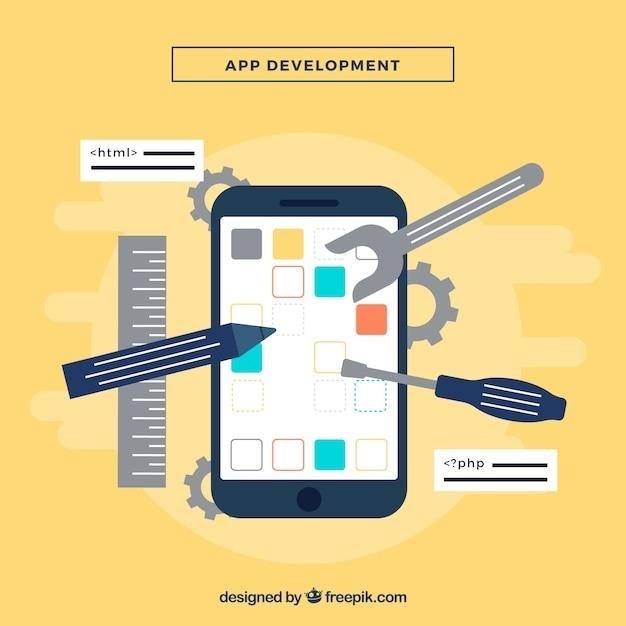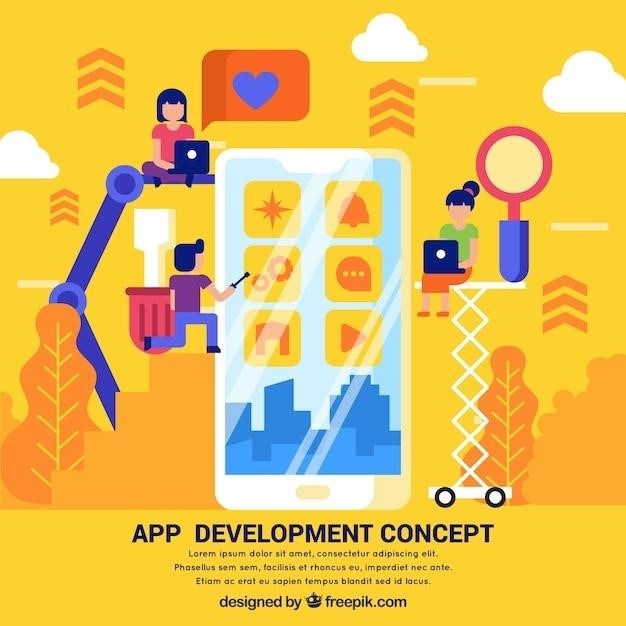What is a Single-Page Application (SPA)?
Definition and Benefits
- Faster User Experience⁚ SPAs load quickly and provide a seamless user experience as there is no need to reload the entire page․ This can lead to increased user engagement and satisfaction․
- Improved Performance⁚ SPAs are typically more efficient than traditional websites, as they only load the necessary data and content․ This can result in faster load times and better overall performance․
- Enhanced Interactivity⁚ SPAs allow for more dynamic and interactive user interfaces, making the user experience more engaging and enjoyable․
- Offline Functionality⁚ Some SPAs can be designed to function offline, providing a seamless user experience even when an internet connection is unavailable․
- Easier to Develop and Maintain⁚ SPAs can be easier to develop and maintain than traditional websites, as they often use fewer files and code․ This can lead to faster development times and reduced maintenance costs․
In conclusion, SPAs offer several benefits over traditional websites, making them a popular choice for modern web applications․ However, it’s important to consider the potential challenges and drawbacks of SPAs before deciding if they are the right fit for your project․
SPA Architecture
The core components of an SPA architecture include⁚
- Frontend⁚ This is the part of the application that users interact with, typically built using JavaScript frameworks like React, Angular, or Vue․js․ It handles user input, displays content, and interacts with the backend API․
- Backend⁚ The backend serves as the data source and business logic for the SPA․ It provides APIs for the frontend to fetch and update data, and handles authentication, authorization, and other server-side tasks․
- Routing⁚ SPAs use client-side routing to navigate between different views within the application․ This allows for smooth transitions between pages without reloading the entire page․
- State Management⁚ SPAs often utilize state management libraries to maintain and update the application’s state consistently across different components․ This ensures data consistency and helps manage complex interactions within the application․
By leveraging these components, SPAs provide a robust and flexible architecture for building modern web applications that offer a user-friendly and interactive experience․
Key Features of SPAs
Single-Page Applications (SPAs) offer a unique set of features that contribute to their growing popularity in modern web development․ These features include⁚
- Enhanced User Experience⁚ SPAs provide a smooth and responsive user experience by eliminating page reloads․ Users can navigate between different sections of the application without waiting for the entire page to refresh, resulting in a more engaging and interactive experience․
- Faster Loading Times⁚ Since only the necessary data and elements are loaded, SPAs can significantly reduce page load times, especially for complex applications․ This leads to improved user satisfaction and reduced bounce rates․
- Offline Functionality⁚ SPAs can be designed to work offline, allowing users to access some features even when they are not connected to the internet․ This is achieved by caching data locally and providing offline-first functionality․
- Rich Interactivity⁚ SPAs offer a rich and dynamic user interface, enabling real-time updates, animations, and interactive elements that enhance user engagement․
- Improved Performance⁚ SPAs can be optimized for performance by leveraging features like caching and asynchronous loading of resources, resulting in a faster and more efficient application․
These key features make SPAs an attractive choice for developers looking to create modern, user-centric web applications that offer a superior experience compared to traditional multi-page websites․
Creating a Simple SPA for Developone
Project Setup
Within the “index․html” file, add the following code⁚
<html lang="en"> <head> <meta charset="UTF-8"> <meta name="viewport" content="width=device-width, initial-scale=1․0"> <title>Developone SPA</title> <link rel="stylesheet" href="css/style․css"> </head> <body> <script src="js/script․js"></script> </body>
Our “index․html” file will serve as the foundation for our SPA․ Let’s start by adding a basic structure that will house the primary content of our application․ We’ll create a simple layout with a header, main content area, and footer․ Within the “body” element of our “index․html” file, add the following HTML code⁚
<header> <h1>Welcome to Developone SPA</h1> <nav> <ul> <li><a href="#home">Home</a></li> <li><a href="#about">About</a></li> <li><a href="#contact">Contact</a></li> </ul> </nav> </header> <main> <section id="home"> <h2>Home</h2> <p>This is the home section of our SPA․</p> </section> <section id="about"> <h2>About Us</h2> <p>This is the about section of our SPA․</p> </section> <section id="contact"> <h2>Contact Us</h2> <p>This is the contact section of our SPA․</p> </section> </main> <footer> <p>© 2024 Developone</p> </footer>
This code creates a simple header with a title and navigation, a main content area with sections for home, about, and contact, and a footer․ This is a basic structure, and we’ll add more content and functionality later․
JavaScript Functionality
const sections = document․querySelectorAll('section');
const navLinks = document․querySelectorAll('nav ul li a');
navLinks․forEach(link => {
link․addEventListener('click', e => {
e․preventDefault;
const targetId = link․getAttribute('href');
sections․forEach(section => {
section․style․display = section․id === targetId ? 'block' ⁚ 'none';
});
});
});
<script src="script․js"></script>
Adding Interactivity
<form id="greetingForm"> <label for="name">Enter your name⁚</label> <input type="text" id="name" name="name"> <button type="submit">Submit</button> </form> <div id="greeting"></div>
Then, modify your “script․js” file to handle the form submission and display the personalized greeting․ In your “script․js” file, add the following JavaScript code⁚
const greetingForm = document․getElementById('greetingForm');
const greeting = document․getElementById('greeting');
greetingForm․addEventListener('submit', e => {
e․preventDefault;
const name = document․getElementById('name')․value;
greeting․textContent = `Hello, ${name}! Welcome to Developone․`;
});
Now, when the form is submitted, the JavaScript code will capture the name entered, display a personalized greeting, and update the content of the “greeting” div without reloading the page․

Essential Libraries and Frameworks
Leveraging libraries and frameworks can significantly streamline your SPA development process, offering pre-built components and tools for efficient coding․
JavaScript Frameworks
JavaScript frameworks provide a structured foundation for building SPAs, offering features like component-based architecture, data binding, and routing․ Popular choices include⁚
- React⁚ A declarative, component-based library known for its virtual DOM and efficient rendering․ React excels in building complex user interfaces and is widely used for SPAs․
- Angular⁚ A comprehensive framework with a strong focus on structure and testability․ Angular offers features like dependency injection, data binding, and a robust CLI for project management․
- Vue․js⁚ A progressive framework known for its simplicity and flexibility․ Vue․js is easy to learn and integrate into existing projects, making it ideal for both small and large SPAs․
Choosing the right framework depends on your project’s specific requirements, team expertise, and desired level of complexity․
UI Libraries
UI libraries streamline the development process by providing pre-built components and styles, allowing you to focus on core application logic․ Popular choices include⁚
- Material-UI⁚ A React library based on Google’s Material Design principles, offering a consistent and aesthetically pleasing UI experience․
- Bootstrap⁚ A widely used CSS framework that provides responsive grid systems, typography, and various UI elements, making it versatile for building SPAs․
These libraries offer a head start in building professional-looking SPAs with minimal effort, allowing you to focus on creating a seamless user experience․
Routing Libraries
Routing libraries are essential for managing navigation within a SPA, allowing users to move between different sections of the application without full page reloads․ These libraries handle URL parsing, component rendering, and state management for a smooth user experience․ Some popular options include⁚
- React Router⁚ A powerful library for React applications, enabling seamless navigation between components and handling URL changes efficiently․
- Vue Router⁚ A dedicated routing library for Vue․js, providing a simple and intuitive API for defining routes and managing navigation within your SPA․
- Angular Router⁚ A built-in routing module for Angular applications, allowing for dynamic routing, lazy loading, and navigation guards for enhanced control over application flow․
By utilizing these libraries, you can create a robust and intuitive navigation system within your SPA, ensuring users can easily access different parts of your application with a seamless experience․

Testing and Deployment
Ensuring your SPA functions correctly and is ready for user interaction requires thorough testing and a seamless deployment process․
Unit Testing
Unit testing is the cornerstone of a robust SPA․ It involves isolating and testing individual components or functions of your application in a controlled environment․ This granular approach helps identify and resolve bugs early in the development cycle, preventing them from cascading into larger issues․
By testing each unit in isolation, you gain confidence in the correctness of your code․ This allows you to refactor and modify existing code without fear of breaking other parts of the application․
Unit testing is particularly crucial for SPAs due to their dynamic nature․ With JavaScript handling most of the application logic, thorough unit testing ensures that each function behaves as expected, contributing to a reliable and predictable user experience․
Popular unit testing frameworks like Jest and Mocha provide a comprehensive suite of tools for writing and running tests․ These frameworks offer features like assertions, mocking, and code coverage reports, empowering developers to write comprehensive and efficient unit tests․
Integration Testing
Integration testing goes beyond individual components and focuses on verifying the interactions and data flow between different parts of your SPA․ It ensures that various units work together seamlessly, as they would in the real world․ This type of testing helps uncover issues that might arise from dependencies between modules, APIs, or databases․
For example, integration tests can validate that user input is correctly handled and processed by multiple components before being submitted to a backend API․ They can also test how data retrieved from an API is displayed on the user interface and whether the UI updates correctly in response to changes in the data․
Integration testing plays a crucial role in ensuring that your SPA’s user experience is consistent and predictable․ By verifying the interactions between components, you can identify and address potential performance bottlenecks or unexpected behaviors that could impact the user’s journey․
Frameworks like Cypress or Selenium provide tools for automating integration tests, making it easier to run tests repeatedly and catch regressions early in the development process․
Deployment Options
After your SPA is thoroughly tested and ready for the world, you need to deploy it to a server where users can access it․ There are several popular deployment options available, each with its own advantages and considerations․
Static hosting services like Netlify, Vercel, or GitHub Pages are excellent choices for simple SPAs that primarily rely on client-side JavaScript․ These services handle the deployment process automatically, minimizing the need for server-side configurations․
For more complex SPAs that require backend functionality, you can deploy to cloud platforms like AWS, Azure, or Google Cloud․ These platforms offer a wide range of services, including databases, load balancers, and content delivery networks, allowing you to scale your SPA as needed․
Alternatively, you can deploy to a traditional web server like Apache or Nginx․ This approach gives you more control over server-side configuration but requires more technical expertise․
The best deployment option for your SPA will depend on factors such as the complexity of your application, your budget, and your comfort level with different technologies․



